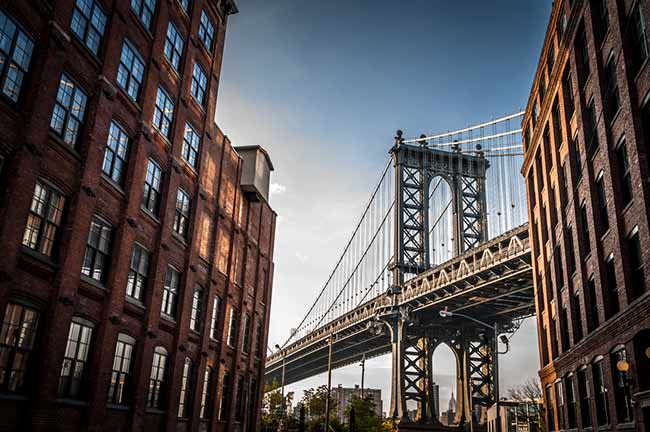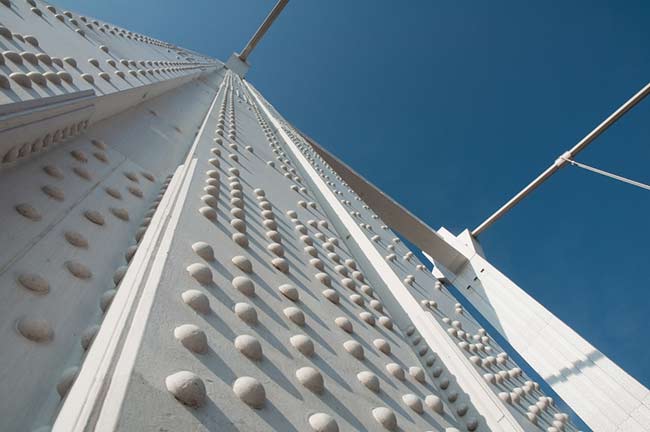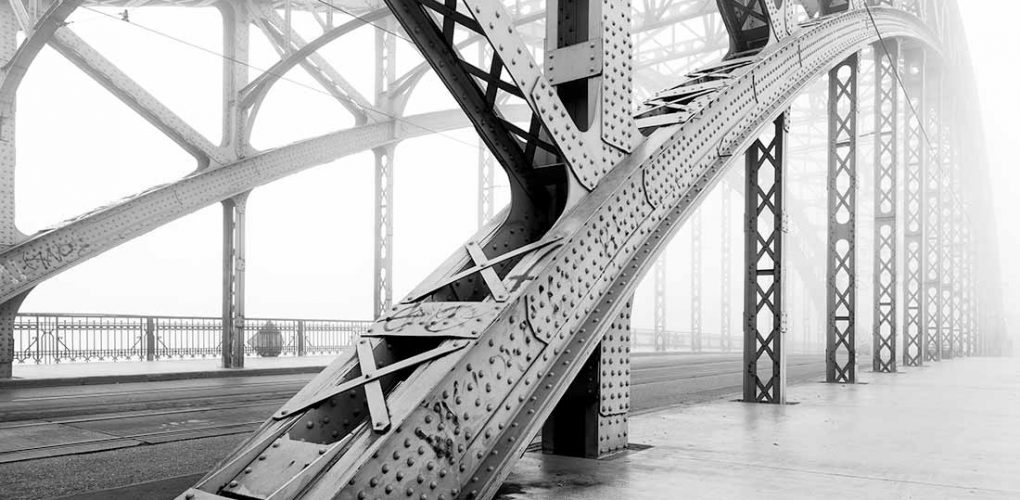According to the National Association of Corrosion Engineers, there are more than 600,000 bridges in the United States. Approximately one-third of them were built using a significant amount of steel, including pipelines and other utility infrastructure components. Steel is one of the most common elements used here in the U.S. and all over the globe to build many types and sizes of bridges, including:
- Long-span bridges
- Highway bridges
- Railroad bridges
- Footbridges
Some of the characteristics of steel that make it an attractive option for bridge builders include its versatility, cost effectiveness, longevity, and sustainability. These qualities allow designers to develop structures that would be impossible to build without steel components.
Many of the great landmark bridges are constructed of steel. Still, it’s important to note that steel bridges aren’t just attractive, they’re generally stronger, safer, faster to build, require less maintenance, and are more flexible, which makes them perfect for earthquake-prone and high-wind sites. Steel is also used to protect elements on bridges, including utility infrastructure.
In addition to all this, environmentalists are more likely to support the construction of steel bridges compared to other types because they’re generally more sustainable and earth-friendly.
The key benefits steel offers bridge developers
| Economic benefits | Environmental benefits | Benefits to society |
| Lower construction costs compared with other materials helps save money for municipal governments.
Faster construction reduces traffic and business disruption. Steel bridges last longer than other types, which means they don’t have to be replaced as quickly. Steel components require less maintenance and don’t need to be replaced as often. The lighter weight of steel means smaller, less costly equipment — including lifts — can be used on construction sites. |
The ability to recycle and reuse steel bridge components reduces environmental impact.
Steel produced in controlled manufacturing environments limits waste. Steel is highly adaptable to different climates and geographic conditions. The relative lightness of steel compared with other materials reduces energy use during delivery and construction. Steel allows longer spans to be built, which limits impact on habitats below. |
Steel bridges are generally safer to build and less likely to fail.
Steel structures can be visually lighter and more attractive than other bridge types. In certain conditions, a bridge made of steel is the only option to connect two areas. Steel components are less likely to be damaged during extreme events like hurricanes and earthquakes. Steel components are used to transmit critical utility services across bridges. |
Let’s look at a few of the benefits of steel in greater detail.
Lightweight construction
Steel has a remarkably high strength-to-weight ratio. This minimizes the weight of bridge superstructures, which reduces the cost of building the substructures that support them. This is particularly beneficial when constructing bridges in places where the ground is unstable, such as river beds and canyons.
Compared to heavier materials, the lower weight of steel lowers the cost of transporting and handling it.
Sustainability
Steel is the most recycled material on the planet. In fact, almost 99 percent of steel from structures that are retired and demolished is returned to the steel-making process or reused as is. This goes a long way toward minimizing negative environmental impact.
More good news: Recycled and reused steel performs at the same level as newly manufactured steel.
Steel bridges are also more likely to be repurposed, since it is relatively easy to relocate them.
Attractive design
Despite its strength — and in some cases, because of it — steel can be bent and twisted to create virtually any type of bridge. Think about it: steel bridges can look light and airy or solid and stable. They can be formed into any shape, from a simple straight line to a complex curve. The surface of steel may be detailed in countless ways and painted a full range of colors. Steel utility infrastructure can be tucked under a bridge and hidden so it does not affect the design.
Faster constructions
Steel is a key contributor to Accelerated Bridge Construction (ABC) techniques. Components are built offsite and shipped to the building location and pieced together. In some cases, complete bridges are built offsite and then moved into place.
These techniques reduce bridge construction time from months or years to days or weeks. This has a positive impact on the cost of projects, the environment, traffic and business disruption, and on-the-job accidents.
The most popular types of steel bridges

Steel can carry loads in tension, compression, and shear. That makes it the perfect material to use in many types of bridges.
Beam bridges
On this type of structure, steel I-beams hold up reinforced concrete deck slabs. The two types of beam bridges are multi-girders, which have multiple steel beams supporting the decking, and ladder decks, which have two, along with additional bracing between the supports. Cost, site conditions, and length must be considered when deciding which beam bridge type to develop.
The benefits of steel: Beam bridges use steel for its strength, not its architectural qualities. They’re built for function and efficiency.
Box girder bridges
Box girders are made of two steel webs joined together at the top and bottom by flanges. This creates a closed cell that provides good torsional stiffness, a quality required on curved bridges.
In beam and slab bridges, box girders, which weigh less, are used instead of plate girders, which are heavier, at the upper end of the span. Engineers must evaluate whether it is worth the higher cost of fabrication to use them for this purpose.
Composite box girder decks can take the form of multiple closed steel boxes, with the deck slab sitting above them, or an open trapezoidal box, closed off by the deck slab.
Longer bridge spans usually leverage either a single box or two of them connected by cross beams. If a bridge is particularly long and minimizing weight is important, an all-steel orthotropic deck is used instead of a reinforced concrete slab.
Now, here’s where things get complicated. For particularly long spans, box girders are likely to be a part of a cable-stayed or suspension bridge. In these hybrid structures, the box girders are custom shaped to improve aerodynamic performance.
The benefits of steel: Steel girder construction helps engineers solve complex bridge design problems.
Truss bridges
Most people are familiar with truss work. It’s the triangulated framework often seen holding up roofs on homes and supporting simpler bridges. Trusses are efficient structural elements because they can act in tension and compression.
In addition to being a bridge type, trusses are frequently used in other types of bridges. They are often a component within arches or act as cantilevers and stiffen girders in suspension bridges.
The benefits of steel: Trusses are less popular than they used to be because they are costly to fabricate. Still, for many bridges, they are the only alternative available to get the job done.
Arch bridges
In these bridges, steel serves the same function as stone or masonry in older structures. It springs upward from — and exerts horizontal thrust on — the foundation. Steel arches act primarily in compression.
The deck may be supported on struts, sit directly on the arch, or be suspended from the arch.
Another variation of this type of bridge is the tied-arch or bow string arch bridge. The deck is hung from the arch above it and acts as a tension tie. It is well suited for bridges that span waterways, where the ground under them is soft.
The benefits of steel: Arch bridges have become more popular in recent decades because they are relatively cost effective, flexible, and architecturally attractive. Using steel on arch bridges gives designers opportunities to expand their creative thinking.
Cable-stayed bridges
Without steel, cable-stayed bridges, today’s most innovative structures, wouldn’t be possible. The main girders of these bridges are supported at defined intervals along the length by tension wires connected to a steel mast or pylon.
Because of the strength of steel, there can be two rows of supports, one on either side of the bridge or a single one down the center. The second option makes bridges seem extraordinarily light and ethereal. The towers, which may take the form of A-frames, H-frames, or columns, act in compression. The deck girders sustain compression and bending forces.
The benefits of steel: Advances in engineering have made it possible for longer cable-stayed bridges to be built. They are now used in places where suspension bridges would have been constructed in the past.
Suspension bridges
These bridges may look complex, but they function in a relatively simple way. Two steel cables are hung between two supports, forming a shallow curve. Additional cables are hung from the supports and connected to the ground. The deck is suspended from these cables by hanging cables. All the steel cables absorb the forces of tension.
The deck acts to stiffen the structure and spread the load across it. When designed correctly, the deck prevents the bridge from bending and twisting. If the deck is not engineered properly, the results can be catastrophic. An example of a suspension bridge designed incorrectly is the Tacoma Narrows bridge, which collapsed because of vibration and twisting that occurred during a windstorm.
The benefits of steel: The relatively low cost of steel cable and the engineering possibilities it offers makes suspension bridges an ideal option to span long distances, such as canyons, bays, and valleys.
Using steel on bridges

Structural steel is available in different grades. It is formed into an array of products with a wide range of sizes and shapes. The steel used to build bridges is prefabricated in controlled factory conditions. This ensures that the steel is consistent, of high quality, and dependably priced.
Some of the processes used to create steelwork for bridges include molding, cutting, drilling, assembling, and welding. Most steel receives a protective coating or treatment that helps it stand up to weather and harsh environmental conditions.
Steel is delivered to bridge construction sites as flat products, such as steel plates and strips, or long products, including beams, channels, and angled components.
Steel is tested before it leaves the factory to ensure it meets specifications defined by the engineers who design bridges and regulatory agencies. These specifications are based on the forces of tension and compression that the components are required to withstand. The bridge designer considers several factors when selecting the grade of steel for a particular bridge component, including:
- Material qualities of the steel
- Design needs
- Cost
- Product availability
- Toughness
- Weldability
- Corrosion resistance
The steel most commonly used on bridges can be grouped into the following categories:
- Carbon steel is the cheapest structural product available. It is used when stiffness is more important than strength.
- High-strength steel is made more durable by adding alloys during the manufacturing process. It’s usually more expensive than carbon steel and requires special welding techniques.
- Weathering steel (also known as corten steel) is a high-strength, low-alloy product manufactured specifically to withstand atmospheric conditions. The anti-corrosive properties of weathering steel extend bridge life to 100 years and beyond.
- Heat-treated carbon steels are the strongest available. The higher strength is the result of exposure to extreme heat.
- Stainless steel is used in places where corrosion resistance is critical, such as safety components, bearings, and guard rails. Usage is limited because of its high cost.
When steel components are delivered to a bridge construction site, they can be:
- Lifted into place by cranes and other types of equipment, which is usually the case with utility infrastructure and other support components.
- Slid into place.
- Rolled to their final positions.
- Transported by boat or vehicle.
- Lifted into place under a bridge.
Once in place, they are bolted and welded together to form the finished structure.
Did you know? Bridge Masters, Inc. can help you install utility infrastructure under steel bridges, a unique area we specialize in.
Learn more
It’s clear why steel is used more often on bridge construction sites, as its unique properties have made it possible to build structures that would have been unimaginable just a few years ago.
Interested in learning more about steel bridge construction? The National Steel Bridge Alliance is a great source of information and a way to connect with others who share similar interests. It’s definitely worth checking them out.

